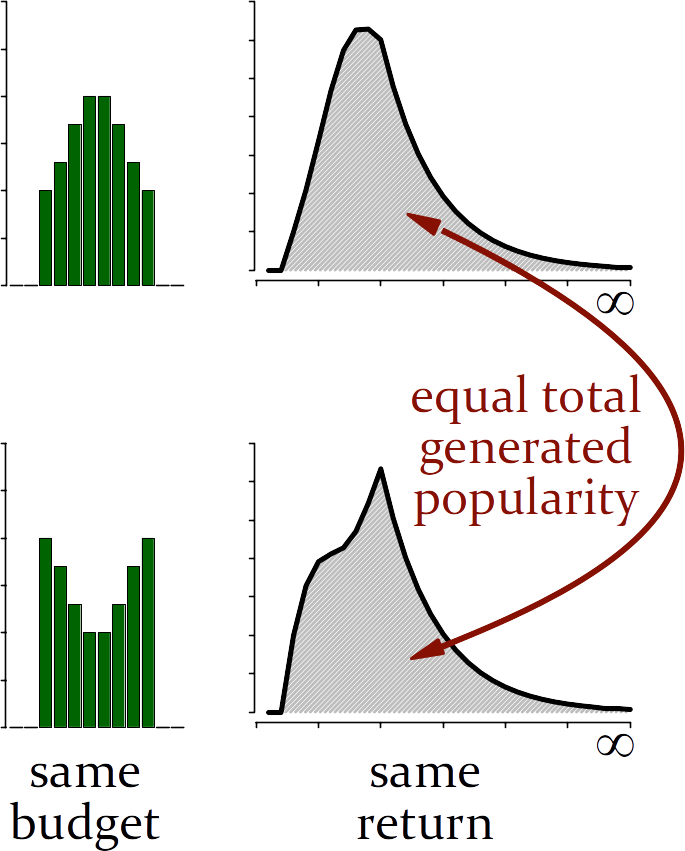posted by Marian-Andrei Rizoiu , edited by Lexing Xie
“The fundamental scarcity in the modern world is the scarcity of attention.” – Herbert A. Simon.
Human attention is a limited resource and influencing the mechanisms governing its allocation is the holy grail of advertisement. Our ICWSM'17 paper applies the recent HIP popularity modeling to further examine popularity under promotion and answer questions such as:
- How much promotion is required for this item to rise to the top 5% in popularity?
- How fast will an item respond to a given amount of promotion?
- Why is constant promotion desirable?
This post is the third of a series on modeling social media popularity using the Hawkes Intensity Process. “Expecting to be HIP (I)” presents a technical overview to a new method for computing expected event rate in unit time for point processes. “Expecting to be HIP (II)” gives an overview of results and interpretations on a large YouTube video dataset.
Popularity under promotion
In the previous post we talked about HIP, our popularity modeling which supplies the missing link between exogenous inputs from public social media platforms (such as Twitter) and endogenous responses within the content distribution platform (like YouTube). While HIP was designed for natural occurring exogenous events (like earthquakes, presidential elections etc.), it turns out that the same modeling principles can be applied for planned promotions (like in the context of advertisement). Our recent work, presented at ICWSM'17, is an in-depth study of popularity dynamics under external promotions. We show how to predict popularity jumps for online videos, and how to construct effective and efficient schedules to promote online content.

Defining viral potential
In any advertisement application, one performs trial campaigns to assess how well products respond to promotion. In a similar fashion, we train our HIP model on the observed popularity series, given known promotion series. Based on the fitted HIP parameters, we can compute a promotion effectiveness measure (dubbed the viral potential score), which is defined as the return on investment: the total amount of attention generated by a single unit of promotion. Based on this quantity we can construct the promotability map, which allows to answer the inverse questions: How much promotion is required to achieve a given popularity goal? Each contour line in Fig.1 represents such goals, the X axis is the computed viral potential score, and the corresponding Y axis is the required promotion budget necessary to achieve the goal. For example, videos $v_1$ and $v_2$ have a relatively high viral potential score and require only $500$ promotions to gain an additional $400,000$ views. Video $v_3$ on the other had has a lower viral potential score and requires more than $1,200$ promotions to achieve the same goal.

<img src="/img/promovability_study/constant_promotion.png" width="250" style="margin-top: 10px, margin-bottom: 5px">
<figcaption>Fig.3: Popularity of a constantly<br/>promoted item.</figcaption>
We would in particular like to highlight two observations that surprised us when they first emerged: the equal returns corollary and effects of constant promotion.
The equal returns corollary
An interesting property emerges from the mathematical form of the HIP model (and briefly touched in a technical post about HIP): HIP is a Linear Time-Invariant system. This property has been intensively studied in domains like signal processing, control theory, time series. It states that the output corresponding to a shifted and scaled version of an input is also shifted and scaled with the same parameters. In HIP this leads to the first surprising conclusion:
Corollary 3.1 (paraphrased informally):
The amount of attention generated by a fixed amount of promotion is, given infinite time, the same irrespective of the timing of the promotions.
In other words, the same promotion budget will always yield the same return. This is shown in Fig.2, where two campaigns, each totaling 100 promotions, have different schedules. The attention series generated by each campaign is different, however the total amount of generated attention (area under each curve) is identical for both.
Why constant promotion is desirable?
In commercial settings, the constant promotion schedule is a commonly adopted strategy.
Take for example the car advertisement appearing every evening before the prime-time TV show. But doesn’t this contradict with the corollary above?
We use the HIP model to provide a plausible explanation: constantly injecting promotion into a social system increases the perceived viral potential,
and the video stays longer in the public attention, thus generating more views. The black line in Fig.3 shows a typical popularity pattern for Youtube videos: the daily viewcount has an initial peak, followed by a steady decay. The red line shows the popularity of the same item, constantly promoted every day with 5 promotions. By contrasting the promoted and the unpromoted relaxation, we see that the daily views in the promoted system have a slower decrease and converge to a non-zero value – the evenly promoted system appears to posses a longer “social memory”. More precisely, this corresponds to a memory parameter with slower decay, as detailed in Section 6.2 of the paper.
If you would like more detail, read this paper, the predecessor paper, or play with the demo!
Resources
Marian-Andrei Rizoiu and Lexing Xie. Online Popularity under Promotion: Viral Potential, Forecasting, and the Economics of Time, in Proceedings of the 11th International AAAI Conference on Web and Social Media (ICWSM’17), p. 10, Montréal, Canada, 2017.
| Download: | Paper PDF + SI Talk slides |
| Data & code: | Github repository |
| Bibtex: |
@inproceedings{Rizoiu2017b,
author = {Rizoiu, Marian-Andrei and Xie, Lexing},
booktitle = {11th International AAAI Conference on Web and Social Media (ICWSM'17)},
keywords = {detection,economics,popularity,prediction,promotion,value of time,viral potential},
pages = {10},
title = {Online Popularity under Promotion: Viral Potential, Forecasting, and the Economics of Time},
year = {2017}
}